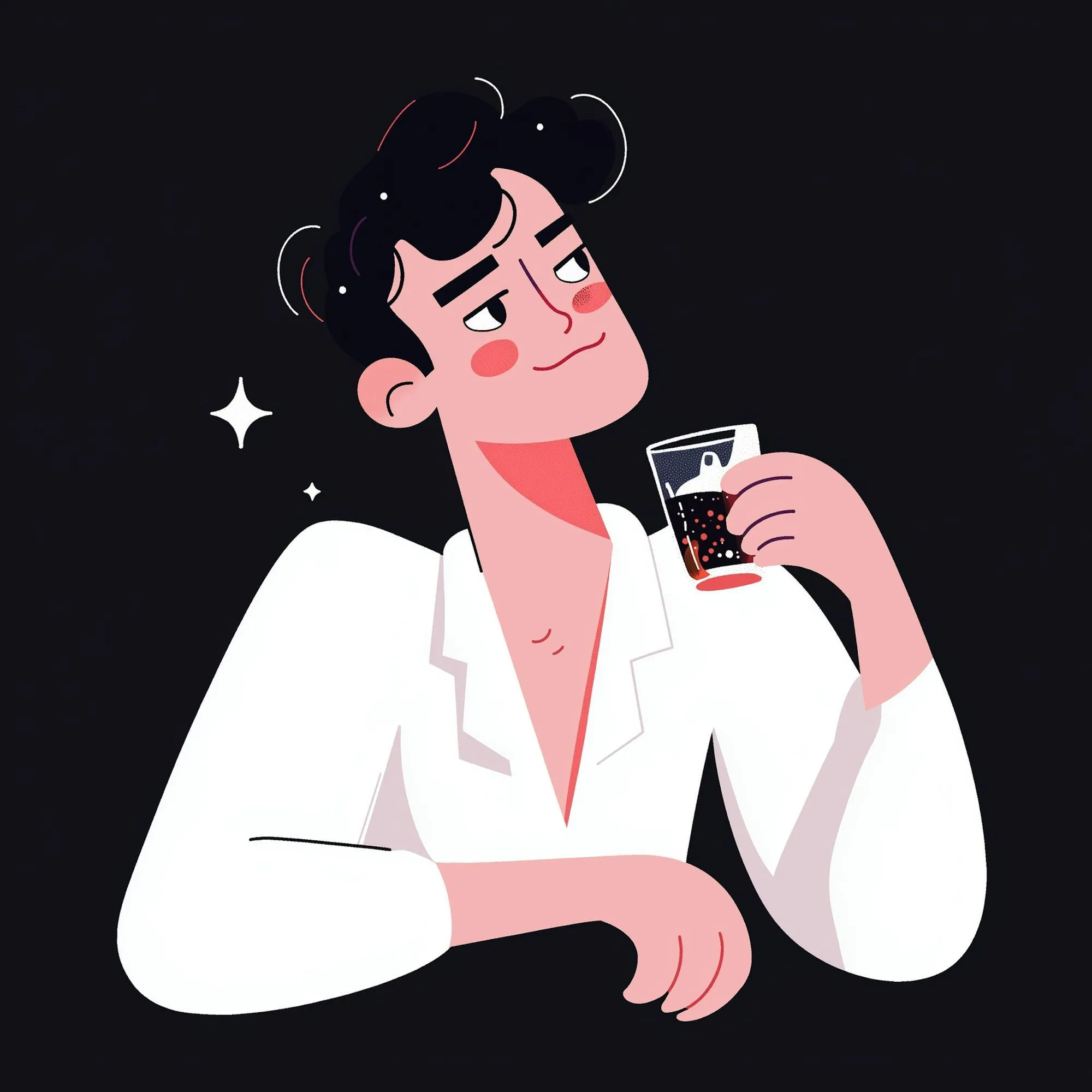Convert Photo to Anime AI Free Tool – Turn Your Pictures into Stunning Anime Art
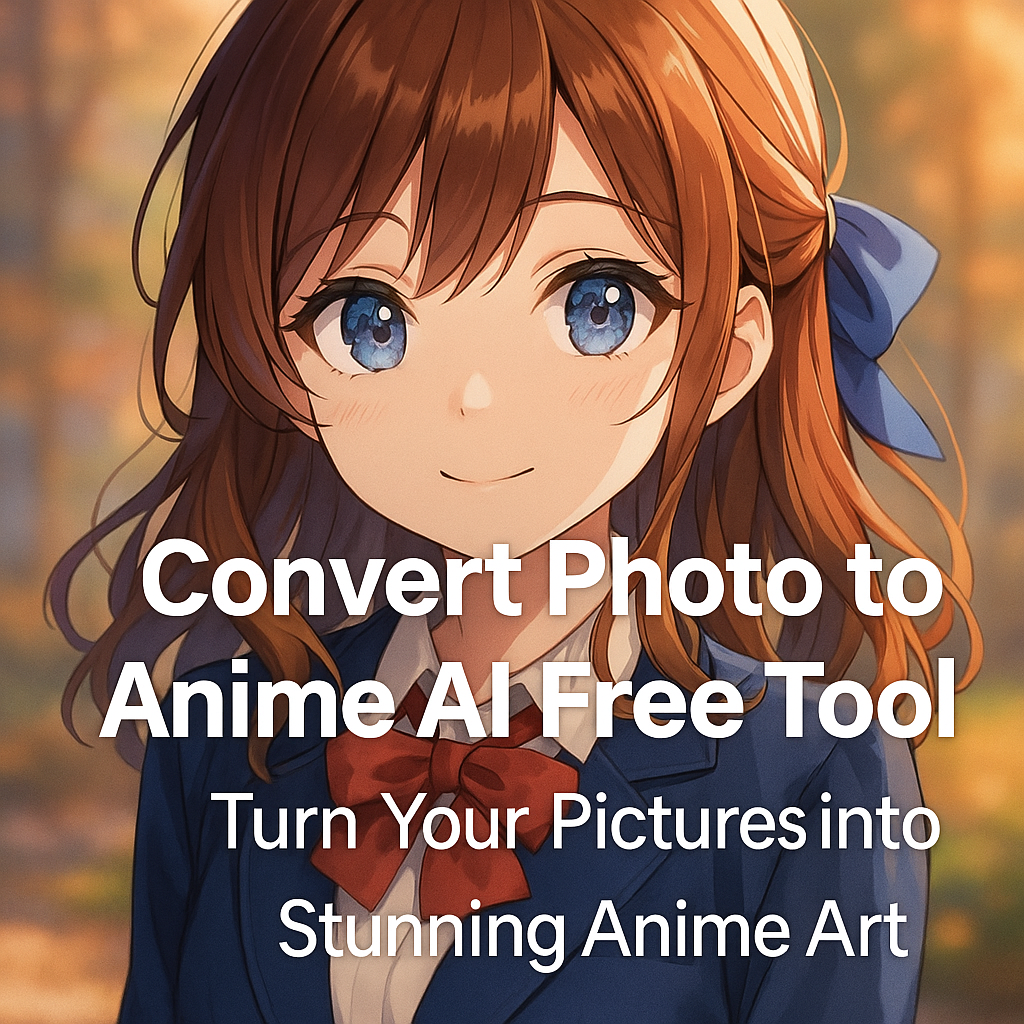
Introduction
Anime-style filters have taken over TikTok, Instagram, and even everyday photo apps. Everywhere you scroll, you see friends and creators transforming themselves into anime characters with big eyes, colorful styles, and playful exaggerations. It’s not just a passing fad—anime art has become part of how people present their digital identity, especially among younger audiences.
The problem is that most free anime conversion tools still fall short. Many are packed with ads, limit you to watermarked exports, or deliver results that look more like blurred cartoons than polished anime illustrations. That’s frustrating for anyone who wants a quick way to experiment with anime art without sacrificing quality.
This is where new AI-powered anime converters step in. By blending neural networks, style transfer models, and customization features, they can accurately reimagine any selfie, portrait, or photo in a professional-looking anime style. These tools are fast, easy, and surprisingly accurate—no art background required.
With the right convert photo to anime AI free tool, you can create stunning anime-style art from any picture. For artists, it’s a way to build inspiration boards. For gamers, it’s a way to design avatars. And for casual users, it’s just fun. The real magic is that the technology is no longer limited to professionals—it’s available free to anyone curious enough to try.
Why Anime AI Photo Converters Are Trending
The Rise of Anime Avatars and Digital Identity
The surge in online anime avatar generator free tools has everything to do with self-expression in the digital era. On TikTok and Instagram, anime filters have gone viral because they give people a new lens to present themselves. Unlike traditional profile photos, anime avatars are playful, customizable, and carry cultural coolness that appeals across fandoms. Users often swap between multiple anime avatars depending on the community they’re interacting with—gaming servers, creative groups, or just their social profiles.
From Fun Filters to Serious Art
What began as a novelty filter has evolved into a creative workflow. Artists are now using AI anime converters to build drafts for manga or explore stylistic variations before sketching. Streamers and gamers are adopting anime avatars as part of their branding because they offer a recognizable, eye-catching look that still feels personal. For many, these avatars are more than fun—they’re a visual identity in digital spaces where creativity matters.
How AI Converts Photos to Anime
AI Anime Style Transfer Technology
At the heart of these tools lies AI anime style transfer technology. Neural networks are trained on vast datasets of anime and manga art, allowing them to map the features of a real photograph into stylized versions that mimic anime conventions. Models like Fooocus and Stable Diffusion use checkpoints optimized for anime, while prompt engineering helps guide the output toward specific styles—from soft shojo aesthetics to bold shonen character looks.
This is what makes the new generation of anime AI filters different from older apps. Instead of just slapping a cartoon overlay, they actually reconstruct facial features, hair textures, and shading based on how anime artists work. The result: outputs that look closer to original anime art rather than generic filters.
Tools and Presets That Matter
One of the most important aspects of achieving good results is selecting the right preset. In Fooocus, for example, there’s a stark difference between the “anime preset” and the “realistic preset.” The anime preset amplifies exaggeration in eyes, outlines, and hair, while the realistic preset tones it down to deliver subtle stylization. Transcripts also highlighted how crucial resolution and style weights are—low resolution produces muddy results, while tuning weights and prompts ensures the model captures both likeness and anime flair.
Key Features of a Good Anime Converter
Not all tools are created equal. The best anime converters share a few must-have features:
- Accuracy: Maintaining the subject’s likeness while translating it into anime proportions.
- Customization: Letting users tweak expressions, hairstyles, or accessories to fit their personality.
- Output Quality: Delivering HD results that can be used for social profiles, content creation, or even print—without ugly watermarks or pixelation.
When those three come together, the tool becomes more than a novelty—it becomes a genuinely creative assistant.
The Top Free AI Tools to Convert Photo to Anime
Fooocus AI – Free, Open Source, Highly Customizable
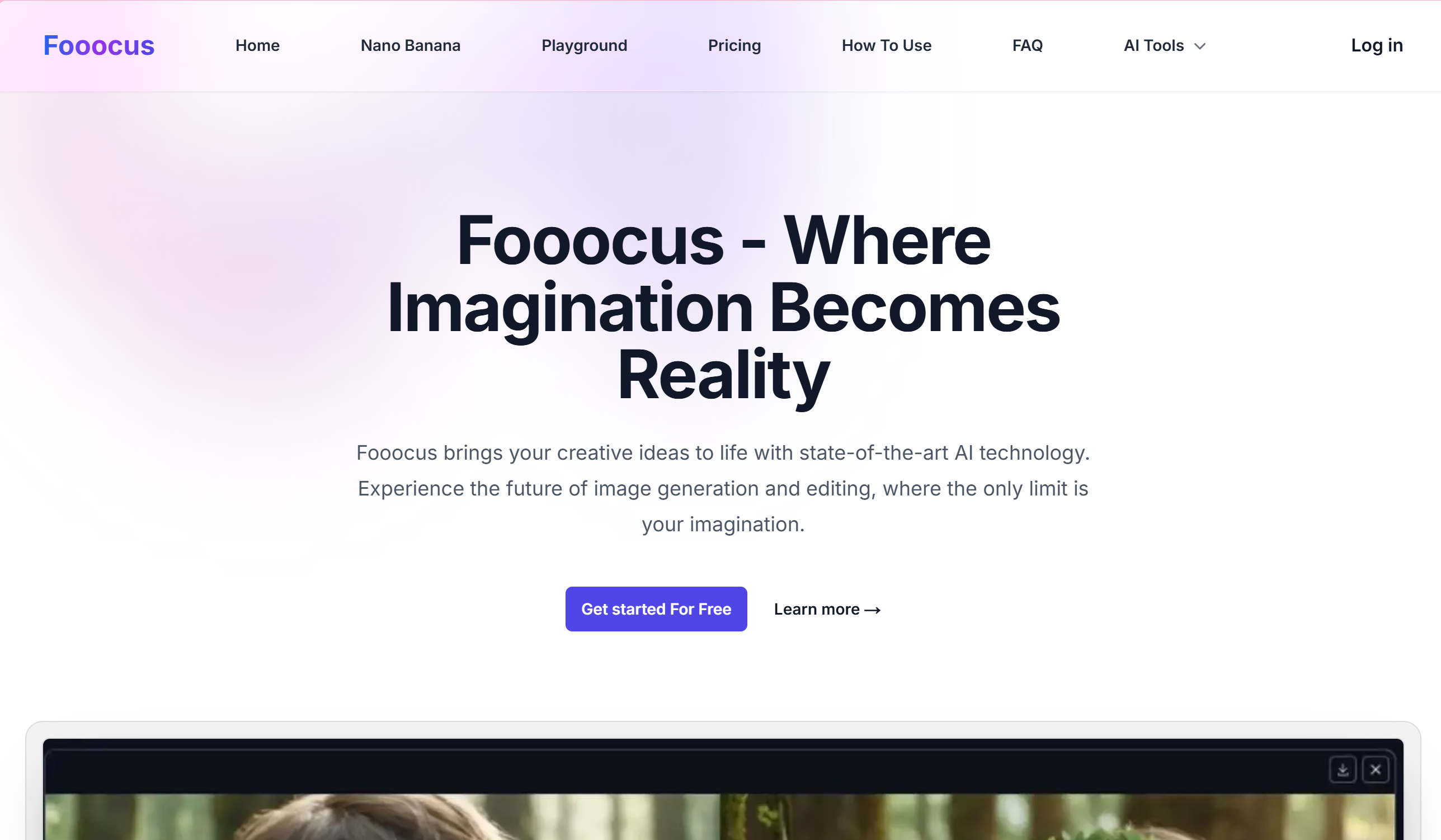
Fooocus stands out as one of the most versatile AI photo to anime transformation online tools. It’s open source, free to use, and designed for hobbyists and creators who want deeper control. What makes it powerful is its anime preset, which was highlighted repeatedly in expert discussions. The anime preset automatically enhances eyes, outlines, and coloring, creating instantly recognizable anime art.
Top Features:
- Anime Preset vs Realistic Preset – allows you to choose between stylized exaggeration or subtle conversion.
- Face Swap & Background Removal – helpful for those who want avatars with custom settings.
- Prompt + Style Weights – lets you fine-tune the level of “anime exaggeration” for accurate likeness.
Review Notes: Users appreciate the customization, but they also admit it takes practice. Without the right prompt or resolution, results can look off-model. Still, for free, this tool is a powerhouse that rivals paid platforms.
Best For: Artists, streamers, and anyone who wants advanced control without cost.
Google Colab + Fooocus – Cloud Anime Conversion

Not everyone has a powerful GPU at home, which is why Google Colab versions of Fooocus are gaining traction. These setups allow you to run anime conversion in the cloud—no expensive hardware required.
Top Features:
- Free GPU Access – Colab provides computing resources, ideal for anime rendering.
- Anime Pencil Model – delivers sketch-like anime styles perfect for comic drafts.
- Accessibility – runs directly in your browser without complex installation.
Review Notes: While it’s incredibly convenient, Colab has its quirks—free sessions time out, and advanced tweaks sometimes require coding comfort. Still, for students, hobbyists, or casual users, this approach removes barriers.
Best For: Beginners who want quality results without investing in high-end PCs.
Meitu & TikTok Filters
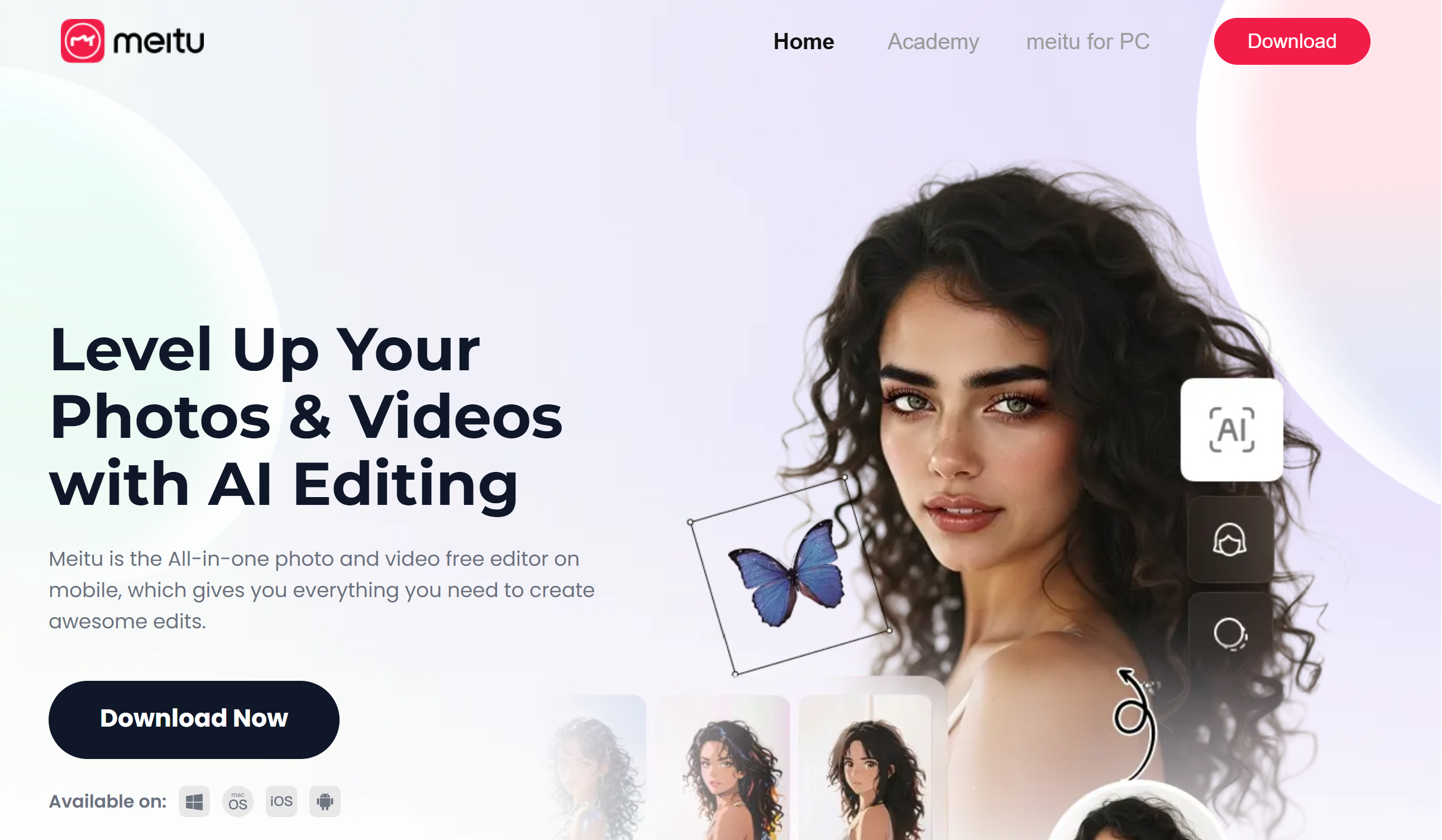
For casual users, tools like Meitu or TikTok’s anime filters are quick, fun, and social-friendly. These are less about top AI anime avatar maker free precision and more about playful experimentation.
Top Features:
- Instant Conversion – selfies are converted in seconds.
- Filters Built for Sharing – optimized for TikTok or Instagram.
- No Learning Curve – one-click transformation.
Review Notes: The downside is customization. You can’t tweak details or improve accuracy, and results often look generic. But for viral trends and social sharing, they’re perfect.
Best For: Social media creators chasing trends or anyone wanting quick anime selfies.
AnimeGAN & Stable Diffusion Models
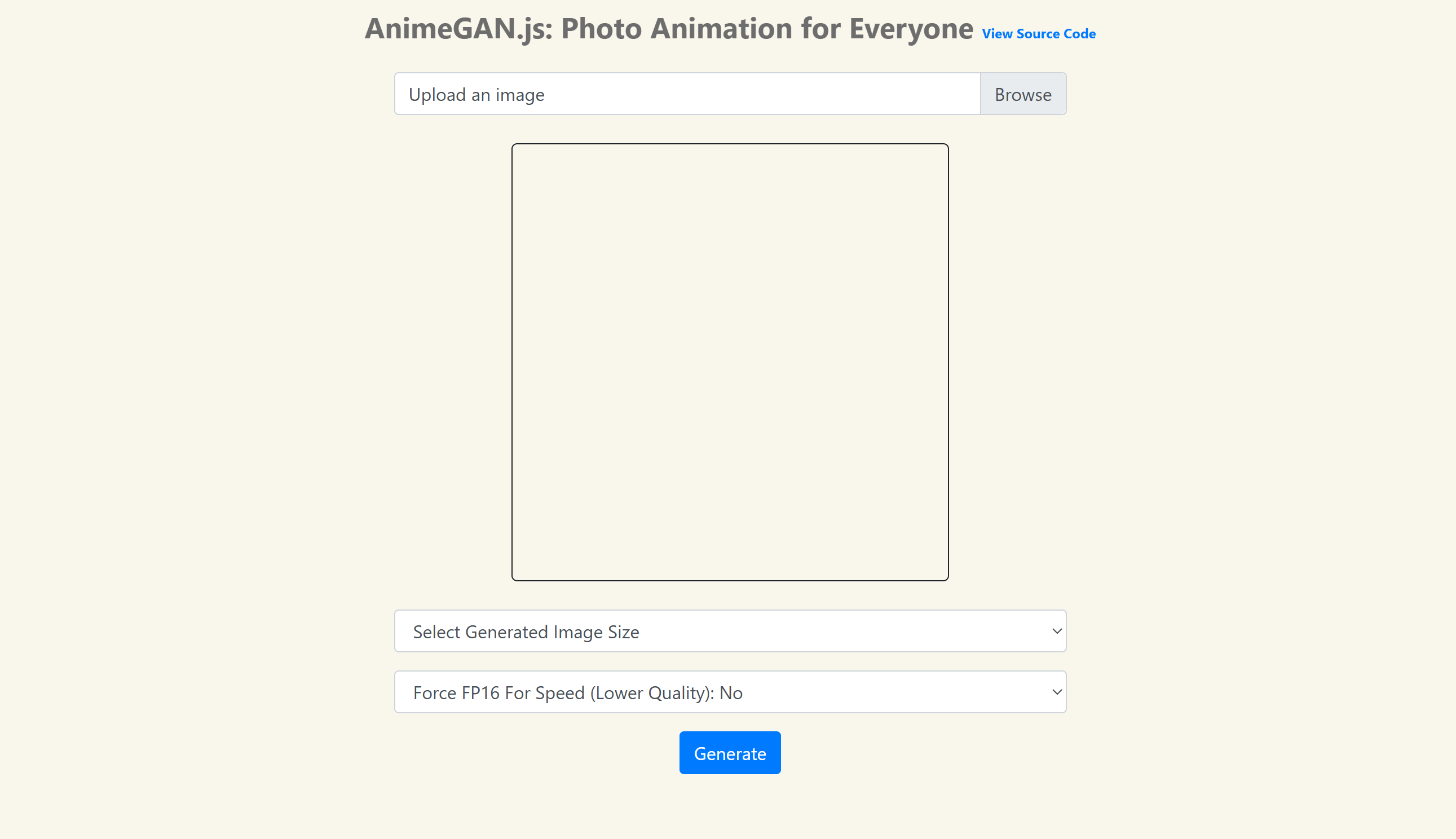
AnimeGAN remains one of the classic models for anime conversion, and paired with Stable Diffusion checkpoints, it continues to be a go-to for developers and creators.
Top Features:
- Open Source Flexibility – customizable, extendable by the community.
- Multiple Checkpoints – from realistic anime to exaggerated manga looks.
- Compatibility – integrates with editing workflows for artists.
Review Notes: The main challenge is complexity. Beginners often find setup confusing. However, the quality can be outstanding once configured.
Best For: Advanced users, developers, and digital artists exploring anime workflows.
DeepAI & Browser-Based APIs
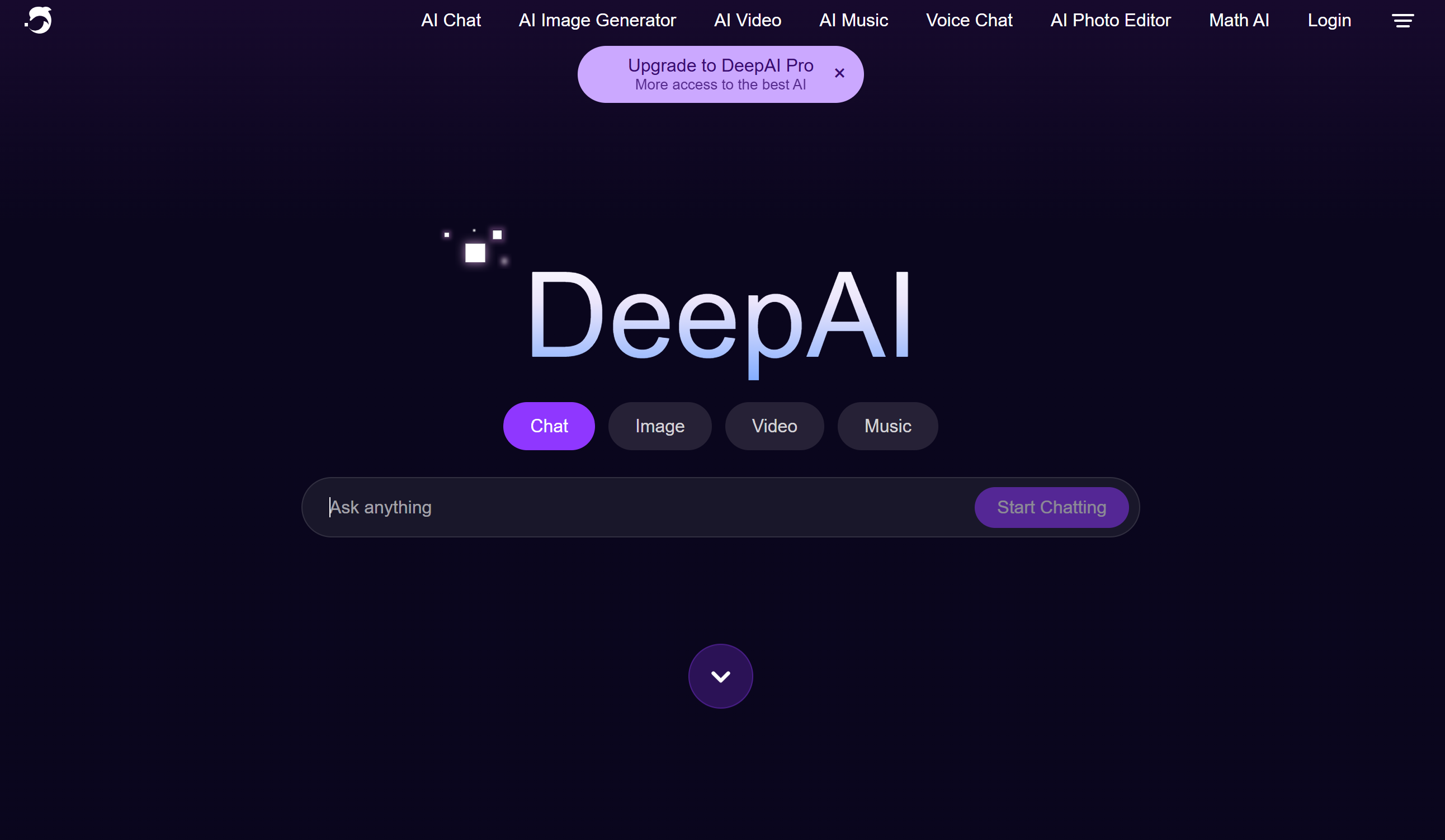
For those who don’t want to install anything, DeepAI’s anime converter and similar web APIs are the simplest option. Just upload a photo, and you get an anime version back.
Top Features:
- One-Click Browser Tool – no setup required.
- Free Access – with optional premium upgrades for HD.
- Fast Processing – immediate results for casual users.
Review Notes: While convenient, outputs are often low resolution and lack customization. These tools are best for experimentation, not professional use.
Best For: Casual users curious about AI anime art without technical barriers.
Comparing Tools at a Glance
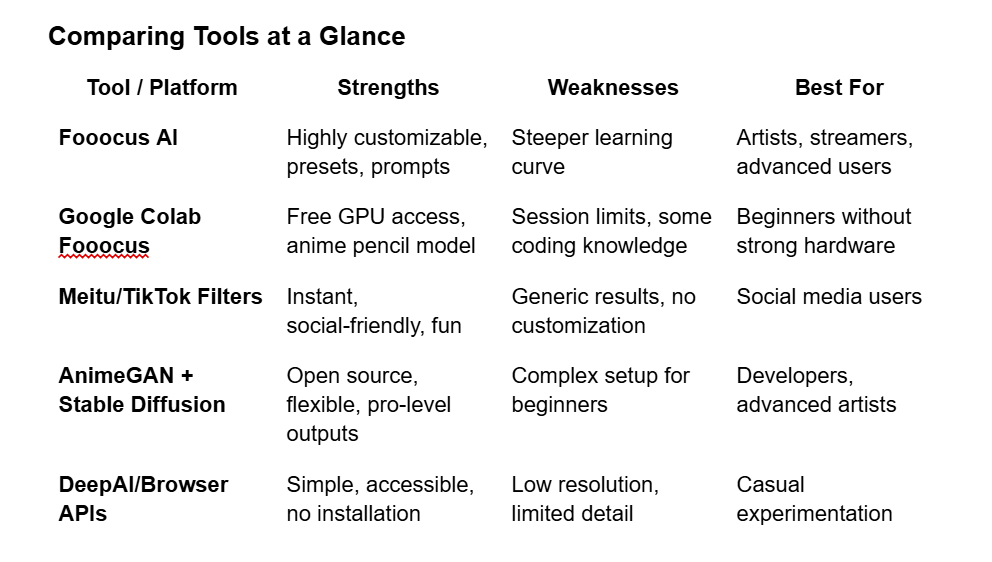
Summary of Tools
From transcripts and hands-on experience, it’s clear that no single platform does everything perfectly. Fooocus and Stable Diffusion deliver the best AI anime style transfer technology, but they demand some learning. TikTok filters and browser tools make anime selfies accessible, but with limited control. Google Colab sits in the sweet spot—free, powerful, and beginner-friendly.
Advanced Editing & Customization Features
One of the biggest reasons users prefer advanced anime converters over one-click filters is control. The ability to refine and customize your results transforms a basic anime selfie into something unique and personal.
Style Presets and Weights
Tools like Fooocus give you direct access to presets—whether you want a soft, shojo-inspired portrait or a bold, manga-style character. The transcripts emphasized how critical style weights are: small adjustments can shift a photo from slightly stylized to full-on anime exaggeration. Choosing between the anime preset and the more subdued realistic preset lets users decide just how far they want to go in their transformation.
Expression & Clothing Customization
Another strength of modern tools is customization beyond just faces. You can add a smile, change expressions, or even introduce accessories like glasses, hats, or cosplay outfits. Some platforms support AI avatar customization for social media profiles, making it easy for streamers and gamers to maintain a distinct digital identity. This level of personalization turns the output from generic to truly brand-worthy.
Fixing Mistakes
Like any AI-generated image, mistakes happen. Hands may look awkward, or hair might clip through accessories. The transcripts highlighted how refining prompts, raising resolution, and adjusting weights can solve most of these issues. Users also often export to Photoshop or Procreate for final polishing.
The bottom line: free AI anime converters aren’t just about quick fun—they’ve evolved into creative studios, where precision and customization empower both casual fans and professional artists.
Pros & Cons of Free AI Anime Converters
The Benefits
Free anime converters have democratized creativity. What once required artistic training can now be done with a selfie and a few clicks. The biggest advantage is accessibility—anyone can experiment with anime art without needing expensive software or commissions. Tools like Fooocus and AnimeGAN provide professional-level outputs, while TikTok filters bring anime avatars to social feeds in seconds.
Another key benefit is customization. Advanced platforms allow control over style weights, presets, and expressions, letting users create avatars that reflect their personality. For artists and gamers, this means building a recognizable identity—whether it’s for streaming, profile pictures, or branded content. The ability to generate HD anime portraits without cost is a massive win for creative communities.
The Limitations
Still, these tools aren’t flawless. Many free platforms add watermarks, restrict resolution, or require GPU power that not all users have. The transcripts noted a recurring issue: while anime presets are great at exaggeration, they sometimes distort likeness or produce awkward features like hands or accessories. Fixes usually involve prompt refinement or external editing.
Another drawback is inconsistency across tools. TikTok filters deliver fun but generic outputs, while open-source models can overwhelm beginners with complexity. Free APIs, on the other hand, offer convenience but lack depth.
In short: free AI anime converters are a fantastic entry point into digital art, but they work best when paired with patience, editing, and sometimes a little technical know-how.
Ethical & Creative Use Cases
For Fun and Social Media
The most common use of anime converters is still pure fun. TikTok and Instagram are filled with viral challenges where users transform selfies into anime characters. Using an online anime avatar generator free, people can instantly share new versions of themselves—sometimes playful, sometimes glamorous, always eye-catching. For casual users, it’s a way to experiment with digital identity without long-term commitment.
For Creators and Artists
In transcripts, experts pointed out how tools like Fooocus are being used not just for selfies, but as creative assistants. Artists use anime presets to sketch ideas, refine character concepts, or even generate manga storyboards. This isn’t about replacing art but enhancing workflows. An illustrator, for instance, might run a portrait through an AI anime filter to get a base sketch, then refine it manually. The combination of AI anime style transfer technology and human skill often produces faster, more innovative results.
For Gamers and Streamers
Anime avatars have also become part of online branding. Streamers on Twitch and YouTube use anime-styled portraits as overlays or profile images, reinforcing their digital persona. Customization features like clothing, accessories, and expressions ensure each avatar feels distinct. For streamers, this isn’t just art—it’s a marketing strategy.
For Businesses and Marketing
Companies are also exploring anime AI as part of branding campaigns. Free anime converters make it possible to generate themed visuals for product launches, seasonal promotions, or campaigns aimed at younger demographics. While this raises ethical questions around originality and artist credit, it also opens doors for cost-effective, attention-grabbing visuals.
At its best, the convert photo to anime AI free tool empowers creativity across audiences—from casual users to professionals—bridging fun, identity, and innovation.
Future of AI Anime Conversion
The technology behind anime converters is evolving at an incredible pace. What started as simple filters has now grown into AI anime style transfer technology capable of generating near-professional results. But the future will push even further, blending photos, animation, and immersive experiences.
AI-Powered Anime Drawing vs. Human Artists
One of the biggest debates is whether AI will replace or complement human anime artists. The transcripts highlighted that while AI can generate likeness and style quickly, it often lacks nuance—storytelling, intentional imperfections, and cultural depth that human creators bring. Rather than replacing artists, the future looks collaborative: AI will handle drafts, while artists refine and elevate the work.
From Photos to Animated Scenes
We’re also moving from static images to motion. Already, experiments are underway with AI-powered anime drawing and animation. Imagine uploading a photo, and instead of just getting an avatar, you receive a short animated clip of yourself in anime form. This opens new doors for gaming, short-form video, and even advertising.
Integration with Social Platforms and AR/VR
Another frontier is AI avatar customization for social media profiles that goes beyond 2D. Avatars will be integrated into virtual spaces like VRChat, or augmented reality platforms where users can “wear” their anime persona in live video. This could transform how people express identity in the metaverse and online communities.
Multimodal Creativity
Future tools won’t just convert photos—they’ll mix text, voice, and movement. For example, you could describe a scene (“my anime version walking in Tokyo at night”), upload a selfie, and instantly generate both the anime character and a video clip.
The future of the convert photo to anime AI free tool isn’t just about creating avatars—it’s about building entire digital identities in anime style.
Conclusion
Anime has always been about imagination, and now AI makes it accessible to anyone with just a photo. From viral TikTok filters to professional tools like Fooocus and Stable Diffusion, the convert photo to anime AI free tool has become a bridge between casual fun and serious creativity.
The transcripts made one point clear: these tools aren’t gimmicks anymore. With style presets, customization, and HD output, they empower users to create avatars, concept art, and branded visuals that feel authentic. The best results come when AI is paired with human creativity—using automation for speed and precision, and human editing for nuance and storytelling.
The pros are obvious: free access, fast results, and endless experimentation. The limitations—watermarks, GPU needs, or occasional errors—are real but manageable, especially as the technology evolves. And the future promises even more: animated outputs, AR/VR avatars, and multimodal creativity where photos, text, and voice merge into one anime experience.
For artists, gamers, streamers, and everyday users, the opportunity is here. With the right AI anime converter, you’re not just creating images—you’re shaping your digital identity. The world of anime is no longer behind a sketchpad. It’s in your pocket, free to explore.
